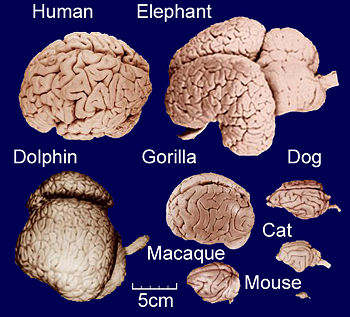Brain size: Difference between revisions
imported>Daniel Mietchen |
imported>Daniel Mietchen (turned keyowrds into phrases) |
||
| Line 8: | Line 8: | ||
==Determinants of brain size== | ==Determinants of brain size== | ||
A number of parameters have been found to be involved in the determination of brain size. These include the [[gene]]s [[microcephalin]] (MCPH1) and [[ASPM]] (MCH 5; for overview, see [[CZ:Ref:Stern 2006 Evolutionary Genetics: is brain evolution still continuing in modern humans?|Stern and Woods, 2006]] and [[CZ:Ref:Tang 2006 Molecular genetic determinants of human brain size|Tang 2006]]), [[habitat density]] (at least in [[bat]]s, cf. [[CZ:Ref:Safi 2005 Bigger is not always better: when brains get smaller|Safi et al., 2005]]), and [[pelvis|pelvic]] size in human females (cf. [[CZ:Ref:Ridley 1995 Pelvic sexual dimorphism and relative neonatal brain size really are related|Ridley 1995]]) as a limiting factor. | |||
==Correlates of brain size== | ==Correlates of brain size== | ||
Further variables interact with brain size but cause and effect in these relationships have not yet been clearly identified. This is the case with [[CZ:Ref:Casanova 2004 Reduced Brain Size and Gyrification in the Brains of Dyslexic Patients|Casanova et al., 2004]]), the maximum rate of population increase ([[CZ:Ref:Isler 2009 Why are there so few smart mammals (but so many smart birds)?|Isler & Van Schaik, 2009]]), the [[basal metabolic rate]] ([[CZ:Ref:Isler 2006 Metabolic costs of brain size evolution|Isler & van Schaik, 2006a]]), the [[flight]] musculature (at least in [[bird]]s, cf. [[CZ:Ref:Isler 2006 Costs of encephalization: the energy trade-off hypothesis tested on birds|Isler & van Schaik, 2006b]]), the [[wing]] area (at least in [[bat]]s, cf. [[CZ:Ref:Safi 2005 Bigger is not always better: when brains get smaller|Safi et al., 2005]]), and some cognitive traits like [[kleptoparasitism]] ([[CZ:Ref:Morand-Ferron 2007 Food stealing in birds: brain or brawn?|Morand-Ferron et al., 2007]]). | |||
==Effects of brain size== | ==Effects of brain size== | ||
Brain size, in turn was found to have an effect on [[gyrification]] (cf. [[CZ:Ref:Hofman 1989 On the evolution and geometry of the brain in mammals|Hofman 1989]] and the [[glia-neuron ratio]] (cf. [[CZ:Ref:Sherwood 2006 Evolution of increased glia-neuron ratios in the human frontal cortex|Sherwood et al., 2006]]). | |||
Revision as of 07:45, 7 May 2009
This article uses direct referencing.

Comparative anatomy of adult brains from various vertebrate species, highlighting the gradual differences in brain size and gyrification.
Since the brain has enlarged considerably during hominid evolution, brain size is a central term in many discussions related to cognitive evolution, intelligence and a number of brain disorders, especially microcephaly. To compare different brains, several indicators of brain size have been used. These include absolute brain size, relative brain size (normalized by body size or weight), and the encephalization coefficient.
Determinants of brain size
A number of parameters have been found to be involved in the determination of brain size. These include the genes microcephalin (MCPH1) and ASPM (MCH 5; for overview, see Stern and Woods, 2006 and Tang 2006), habitat density (at least in bats, cf. Safi et al., 2005), and pelvic size in human females (cf. Ridley 1995) as a limiting factor.
Correlates of brain size
Further variables interact with brain size but cause and effect in these relationships have not yet been clearly identified. This is the case with Casanova et al., 2004), the maximum rate of population increase (Isler & Van Schaik, 2009), the basal metabolic rate (Isler & van Schaik, 2006a), the flight musculature (at least in birds, cf. Isler & van Schaik, 2006b), the wing area (at least in bats, cf. Safi et al., 2005), and some cognitive traits like kleptoparasitism (Morand-Ferron et al., 2007).
Effects of brain size
Brain size, in turn was found to have an effect on gyrification (cf. Hofman 1989 and the glia-neuron ratio (cf. Sherwood et al., 2006).